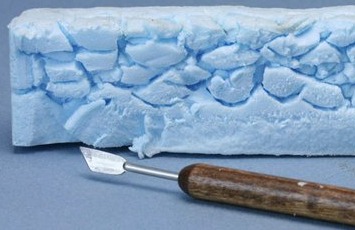Make a fake surface
Make a fake rock surface using crumpled paper, papier mache or clay and paint to practice texture, painting, and safe crafting techniques.



Step-by-step guide to make a fake rock surface
Easy Paper Craft Ideas for Home | How to Make Art and Craft with Paper at Home Without Glue
Step 1
Gather all materials from the list and bring them to your workspace.
Step 2
Cover your work surface with the plastic sheet or old newspaper to protect it.
Step 3
Crumple several sheets of scrap paper into medium sized lumps to make rock cores.
Step 4
Use masking tape to join and shape the crumpled lumps into one rock form.
Step 5
Decide whether you will use papier-mâché or air-dry clay for the outside texture.
Step 6
If you chose papier-mâché mix equal parts white glue and water in the bowl until smooth.
Step 7
If you chose papier-mâché dip the strips into the paste and smooth them over the rock core covering it with two to three layers.
Step 8
If you chose air-dry clay press and smooth the clay over the rock core and add bumps cracks and indents for texture.
Step 9
Let your rock dry completely until it is hard to the touch which can take about 4 to 24 hours depending on thickness.
Step 10
Paint a base coat of a rock color over the dry surface and let that layer dry.
Step 11
Add texture and details by dabbing with a sponge or by dry brushing lighter and darker tones and let it dry.
Step 12
Share your finished rock surface creation by posting a photo on DIY.org.
Final steps
You're almost there! Complete all the steps, bring your creation to life, post it, and conquer the challenge!


Help!?
What can we use instead of white glue, air-dry clay, or a plastic sheet if we don't have them?
If you don't have white glue for the equal-parts glue-and-water papier-mâché paste, substitute a flour-and-water paste (mix flour and water until smooth); if you lack air-dry clay use thicker papier-mâché layers over the taped rock core; and use a trash bag or old shower curtain in place of the plastic sheet to protect your work surface.
What should we do if the papier-mâché won't stick or the rock shape collapses while making the core?
If strips won't stick or the crumpled paper core shifts, reinforce the crumpled lumps with extra masking tape at the join-and-shape step, fully saturate and press each papier-mâché strip flat when applying the two to three layers, and allow the piece to dry on a flat surface for the recommended 4–24 hours before painting.
How can we adapt the project for very young children or older kids?
For younger children, have them only crumple scrap paper and help tape lumps together while an adult handles the glue paste and drying, and for older kids, encourage using air-dry clay to press in detailed bumps, cracks, and indents and to experiment with sponge dabbing and dry brushing after the base coat.
What are some ways to make the fake rock surface more realistic or longer-lasting?
To enhance the finished rock, add small toy fossils or pebbles pressed into the air-dry clay before the 4–24 hour dry time, layer sponge dabs and dry-brushed lighter and darker tones after the base coat for depth, and seal with a clear outdoor sealer if you plan to display it outside before sharing a photo on DIY.org.
Watch videos on how to make a fake rock surface
Creative Paper Craft Ideas for Kids | Fun and Easy Step by Step Craft Projects
Facts about sculpting and papier-mâché for kids
✅ Choose non-toxic, washable paints and craft materials (look for “non-toxic” or ASTM D-4236 labeling) to keep rock-making safe for kids.
✋ Making textured surfaces like fake rocks helps kids develop fine motor skills and tactile sensory awareness.
🎨 Acrylic paint dries quickly — thin layers can set in about 10–30 minutes, making it great for building up painted textures.
🪨 Movie sets, zoos, and theme parks often use faux rock (papier-mâché, foam, or sculpted clay) because it’s much lighter and cheaper than real stone.
🧻 Papier-mâché literally means “chewed paper” in French and has been used for decorative crafts and masks for centuries.
How do I make a fake rock surface with crumpled paper, papier-mâché or clay?
What materials do I need to make a fake rock surface?
What ages is making a fake rock surface suitable for?
What are the benefits, safety tips, and fun variations for this fake rock craft?


One subscription, many ways to play and learn.
Only $6.99 after trial. No credit card required



